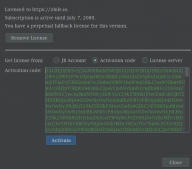本文实例讲述了Python SVM(支持向量机)实现方法。分享给大家供大家参考,具体如下:
运行环境
- Pyhton3
- numpy(科学计算包)
- matplotlib(画图所需,不画图可不必)
计算过程
st=>start: 开始
e=>end: 结束
op1=>operation: 读入数据
op2=>operation: 格式化数据
cond=>condition: 是否达到迭代次数
op3=>operation: 寻找超平面分割最小间隔
ccond=>conditon: 数据是否改变
op4=>operation: 输出结果
st->op1->op2->cond
cond(yes)->op4->e
cond(no)->op3
啊,这markdown flow好难用,我决定就画到这吧=。=
输入样例
|
1
2
3
4
5
6
7
8
9
10
11
12
13
14
15
16
17
18
19
20
21
22
23
24
25
26
27
28
29
30
31
32
33
34
35
36
37
38
39
40
41
42
43
44
45
46
47
48
49
50
51
52
53
54
55
56
57
58
59
60
61
62
63
64
65
66
67
68
69
70
71
72
73
74
75
76
77
78
79
80
81
82
83
84
85
86
87
88
89
90
91
92
93
94
95
96
97
98
99
100
101
|
/* testSet.txt */3.542485 1.977398 -13.018896 2.556416 -17.551510 -1.580030 12.114999 -0.004466 -18.127113 1.274372 17.108772 -0.986906 18.610639 2.046708 12.326297 0.265213 -13.634009 1.730537 -10.341367 -0.894998 -13.125951 0.293251 -12.123252 -0.783563 -10.887835 -2.797792 -17.139979 -2.329896 11.696414 -1.212496 -18.117032 0.623493 18.497162 -0.266649 14.658191 3.507396 -18.197181 1.545132 11.208047 0.213100 -11.928486 -0.321870 -12.175808 -0.014527 -17.886608 0.461755 13.223038 -0.552392 -13.628502 2.190585 -17.407860 -0.121961 17.286357 0.251077 12.301095 -0.533988 -1-0.232542 -0.547690 -13.457096 -0.082216 -13.023938 -0.057392 -18.015003 0.885325 18.991748 0.923154 17.916831 -1.781735 17.616862 -0.217958 12.450939 0.744967 -17.270337 -2.507834 11.749721 -0.961902 -11.803111 -0.176349 -18.804461 3.044301 11.231257 -0.568573 -12.074915 1.410550 -1-0.743036 -1.736103 -13.536555 3.964960 -18.410143 0.025606 17.382988 -0.478764 16.960661 -0.245353 18.234460 0.701868 18.168618 -0.903835 11.534187 -0.622492 -19.229518 2.066088 17.886242 0.191813 12.893743 -1.643468 -11.870457 -1.040420 -15.286862 -2.358286 16.080573 0.418886 12.544314 1.714165 -16.016004 -3.753712 10.926310 -0.564359 -10.870296 -0.109952 -12.369345 1.375695 -11.363782 -0.254082 -17.279460 -0.189572 11.896005 0.515080 -18.102154 -0.603875 12.529893 0.662657 -11.963874 -0.365233 -18.132048 0.785914 18.245938 0.372366 16.543888 0.433164 1-0.236713 -5.766721 -18.112593 0.295839 19.803425 1.495167 11.497407 -0.552916 -11.336267 -1.632889 -19.205805 -0.586480 11.966279 -1.840439 -18.398012 1.584918 17.239953 -1.764292 17.556201 0.241185 19.015509 0.345019 18.266085 -0.230977 18.545620 2.788799 19.295969 1.346332 12.404234 0.570278 -12.037772 0.021919 -11.727631 -0.453143 -11.979395 -0.050773 -18.092288 -1.372433 11.667645 0.239204 -19.854303 1.365116 17.921057 -1.327587 18.500757 1.492372 11.339746 -0.291183 -13.107511 0.758367 -12.609525 0.902979 -13.263585 1.367898 -12.912122 -0.202359 -11.731786 0.589096 -12.387003 1.573131 -1 |
代码实现
|
1
2
3
4
5
6
7
8
9
10
11
12
13
14
15
16
17
18
19
20
21
22
23
24
25
26
27
28
29
30
31
32
33
34
35
36
37
38
39
40
41
42
43
44
45
46
47
48
49
50
51
52
53
54
55
56
57
58
59
60
61
62
63
64
65
66
67
68
69
70
71
72
73
74
75
76
77
78
79
80
81
82
83
84
85
86
87
88
89
90
91
92
93
94
95
96
97
98
99
100
101
102
103
104
105
106
107
108
109
110
111
112
113
114
115
116
117
118
119
120
121
122
123
124
125
126
127
128
129
130
131
132
133
134
135
136
137
138
139
140
141
142
143
144
145
146
147
148
149
150
151
152
153
154
155
156
157
158
159
160
161
162
163
164
165
166
167
168
169
170
171
172
173
174
175
176
|
# -*- coding:utf-8 -*-#!python3__author__ = 'Wsine'from numpy import *import matplotlib.pyplot as pltimport operatorimport timedef loadDataSet(fileName): dataMat = [] labelMat = [] with open(fileName) as fr: for line in fr.readlines(): lineArr = line.strip().split('\t') dataMat.append([float(lineArr[0]), float(lineArr[1])]) labelMat.append(float(lineArr[2])) return dataMat, labelMatdef selectJrand(i, m): j = i while (j == i): j = int(random.uniform(0, m)) return jdef clipAlpha(aj, H, L): if aj > H: aj = H if L > aj: aj = L return ajclass optStruct: def __init__(self, dataMatIn, classLabels, C, toler): self.X = dataMatIn self.labelMat = classLabels self.C = C self.tol = toler self.m = shape(dataMatIn)[0] self.alphas = mat(zeros((self.m, 1))) self.b = 0 self.eCache = mat(zeros((self.m, 2)))def calcEk(oS, k): fXk = float(multiply(oS.alphas, oS.labelMat).T * (oS.X * oS.X[k, :].T)) + oS.b Ek = fXk - float(oS.labelMat[k]) return Ekdef selectJ(i, oS, Ei): maxK = -1 maxDeltaE = 0 Ej = 0 oS.eCache[i] = [1, Ei] validEcacheList = nonzero(oS.eCache[:, 0].A)[0] if (len(validEcacheList)) > 1: for k in validEcacheList: if k == i: continue Ek = calcEk(oS, k) deltaE = abs(Ei - Ek) if (deltaE > maxDeltaE): maxK = k maxDeltaE = deltaE Ej = Ek return maxK, Ej else: j = selectJrand(i, oS.m) Ej = calcEk(oS, j) return j, Ejdef updateEk(oS, k): Ek = calcEk(oS, k) oS.eCache[k] = [1, Ek]def innerL(i, oS): Ei = calcEk(oS, i) if ((oS.labelMat[i] * Ei < -oS.tol) and (oS.alphas[i] < oS.C)) or ((oS.labelMat[i] * Ei > oS.tol) and (oS.alphas[i] > 0)): j, Ej = selectJ(i, oS, Ei) alphaIold = oS.alphas[i].copy() alphaJold = oS.alphas[j].copy() if (oS.labelMat[i] != oS.labelMat[j]): L = max(0, oS.alphas[j] - oS.alphas[i]) H = min(oS.C, oS.C + oS.alphas[j] - oS.alphas[i]) else: L = max(0, oS.alphas[j] + oS.alphas[i] - oS.C) H = min(oS.C, oS.alphas[j] + oS.alphas[i]) if (L == H): # print("L == H") return 0 eta = 2.0 * oS.X[i, :] * oS.X[j, :].T - oS.X[i, :] * oS.X[i, :].T - oS.X[j, :] * oS.X[j, :].T if eta >= 0: # print("eta >= 0") return 0 oS.alphas[j] -= oS.labelMat[j] * (Ei - Ej) / eta oS.alphas[j] = clipAlpha(oS.alphas[j], H, L) updateEk(oS, j) if (abs(oS.alphas[j] - alphaJold) < 0.00001): # print("j not moving enough") return 0 oS.alphas[i] += oS.labelMat[j] * oS.labelMat[i] * (alphaJold - oS.alphas[j]) updateEk(oS, i) b1 = oS.b - Ei - oS.labelMat[i] * (oS.alphas[i] - alphaIold) * oS.X[i, :] * oS.X[i, :].T - oS.labelMat[j] * (oS.alphas[j] - alphaJold) * oS.X[i, :] * oS.X[j, :].T b2 = oS.b - Ei - oS.labelMat[i] * (oS.alphas[i] - alphaIold) * oS.X[i, :] * oS.X[j, :].T - oS.labelMat[j] * (oS.alphas[j] - alphaJold) * oS.X[j, :] * oS.X[j, :].T if (0 < oS.alphas[i]) and (oS.C > oS.alphas[i]): oS.b = b1 elif (0 < oS.alphas[j]) and (oS.C > oS.alphas[j]): oS.b = b2 else: oS.b = (b1 + b2) / 2.0 return 1 else: return 0def smoP(dataMatIn, classLabels, C, toler, maxIter, kTup=('lin', 0)): """ 输入:数据集, 类别标签, 常数C, 容错率, 最大循环次数 输出:目标b, 参数alphas """ oS = optStruct(mat(dataMatIn), mat(classLabels).transpose(), C, toler) iterr = 0 entireSet = True alphaPairsChanged = 0 while (iterr < maxIter) and ((alphaPairsChanged > 0) or (entireSet)): alphaPairsChanged = 0 if entireSet: for i in range(oS.m): alphaPairsChanged += innerL(i, oS) # print("fullSet, iter: %d i:%d, pairs changed %d" % (iterr, i, alphaPairsChanged)) iterr += 1 else: nonBoundIs = nonzero((oS.alphas.A > 0) * (oS.alphas.A < C))[0] for i in nonBoundIs: alphaPairsChanged += innerL(i, oS) # print("non-bound, iter: %d i:%d, pairs changed %d" % (iterr, i, alphaPairsChanged)) iterr += 1 if entireSet: entireSet = False elif (alphaPairsChanged == 0): entireSet = True # print("iteration number: %d" % iterr) return oS.b, oS.alphasdef calcWs(alphas, dataArr, classLabels): """ 输入:alphas, 数据集, 类别标签 输出:目标w """ X = mat(dataArr) labelMat = mat(classLabels).transpose() m, n = shape(X) w = zeros((n, 1)) for i in range(m): w += multiply(alphas[i] * labelMat[i], X[i, :].T) return wdef plotFeature(dataMat, labelMat, weights, b): dataArr = array(dataMat) n = shape(dataArr)[0] xcord1 = []; ycord1 = [] xcord2 = []; ycord2 = [] for i in range(n): if int(labelMat[i]) == 1: xcord1.append(dataArr[i, 0]) ycord1.append(dataArr[i, 1]) else: xcord2.append(dataArr[i, 0]) ycord2.append(dataArr[i, 1]) fig = plt.figure() ax = fig.add_subplot(111) ax.scatter(xcord1, ycord1, s=30, c='red', marker='s') ax.scatter(xcord2, ycord2, s=30, c='green') x = arange(2, 7.0, 0.1) y = (-b[0, 0] * x) - 10 / linalg.norm(weights) ax.plot(x, y) plt.xlabel('X1'); plt.ylabel('X2') plt.show()def main(): trainDataSet, trainLabel = loadDataSet('testSet.txt') b, alphas = smoP(trainDataSet, trainLabel, 0.6, 0.0001, 40) ws = calcWs(alphas, trainDataSet, trainLabel) print("ws = \n", ws) print("b = \n", b) plotFeature(trainDataSet, trainLabel, ws, b)if __name__ == '__main__': start = time.clock() main() end = time.clock() print('finish all in %s' % str(end - start)) |
输出样例
ws =
[[ 0.65307162]
[-0.17196128]]
b =
[[-2.89901748]]
finish all in 2.5683854014099112

绘图方面还存在一些bug。
希望本文所述对大家Python程序设计有所帮助。
原文链接:https://www.cnblogs.com/wsine/p/5180615.html





